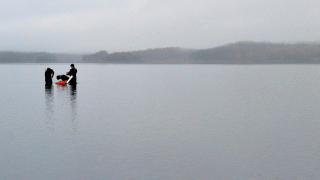
Federal officials announced a plan Tuesday to reduce pollution in one of the largest estuaries in the Northeast.
In the draft Clean Water Permit for the Great Bay in New Hampshire, the Environmental Protection Agency calls for a dozen communities that ring the bay to reduce the amounts of nitrogen going into the waters, rather than focusing on one community as it has in the past.
The move is expected to improve water quality for birds, fish and other marine life that depend upon the waters. The bay also has some of the largest eelgrass meadows along the East Coast.
For years, nitrogen discharges into the bay have led to low oxygen levels and algae blooms, among other problems. The nitrogen has also reduced the water clarity, which has contributed to eel grass beds declining by as much as 80% since the 1990s.
“This draft permit is another step toward a cleaner, healthier Great Bay and reflects many years of hard work among federal, state and local governments to address a critical environmental problem,” said EPA New England Regional Administrator Dennis Deziel. “We expect the end result to be a permit that achieves important reductions of nitrogen in Great Bay in a cost-effective way, which is good news for New Hampshire communities and their ratepayer customers.”
New Hampshire Gov. Chris Sununu, a Republican, also praised the EPA’s approach, which allows communities to shift away from further costly upgrades to their wastewater treatment plants and focus on less expensive methods of reducing nitrogen, such as treating nitrogen from storm water runoff and septic tanks.
But some critics have questioned this approach, saying it allows communities to avoid costly upgrades to their water treatment plants and won’t reduce nitrogen levels low enough for the bay to fully recover.
Local
Communities along the bay have spent more than $200 million reducing nitrogen from their wastewater treatment plants. Those moves have cut nitrogen releases by 70%, but the EPA says more needs to be done.
“These draft rules allow for greater flexibility for our local municipalities,” Sununu said.
John Storer, the director of community services in Dover, said the city “wholeheartedly” supports the plan’s approach. It is one of the 12 communities that would be subject to the permit.
“Dover has voluntarily made significant upgrades to its wastewater treatment plant discharge, so we are encouraged that a proposed adaptive management approach might allow us to focus on stormwater upgrades for continued nitrogen reductions,” he said.
Fred Short, a noted seagrass expert who coordinates the monitoring of 135 sites around the world from his University of New Hampshire lab, welcomed the EPA announcement. He has credited past nitrogen reductions with a 20% recovery of eelgrass in the bay.
“By altering the focus from the concentrations of nitrogen in the wastewater treatment facility alone to the total amount of nitrogen entering the bay waters, the EPA announcement will help to rebuild a cleaner and more productive ecosystem,” he said.
The permit allows the communities to keep nitrogen levels from their wastewater treatments at current levels. In exchange, the communities have agreed to follow a 23-year state plan that calls for a 45% reduction from other nitrogen from other sources like storm water runoff. Rochester would also have to make upgrades to their water treatment plant.
A similar approach is being tried in Massachusetts with a federal storm water permit that calls for dozens of communities in the Charles River watershed to reduce phosphorus. A state permit in Connecticut calls for dozens of communities to reduce nitrogen from their wastewater treatment plans into the Long Island Sound.



